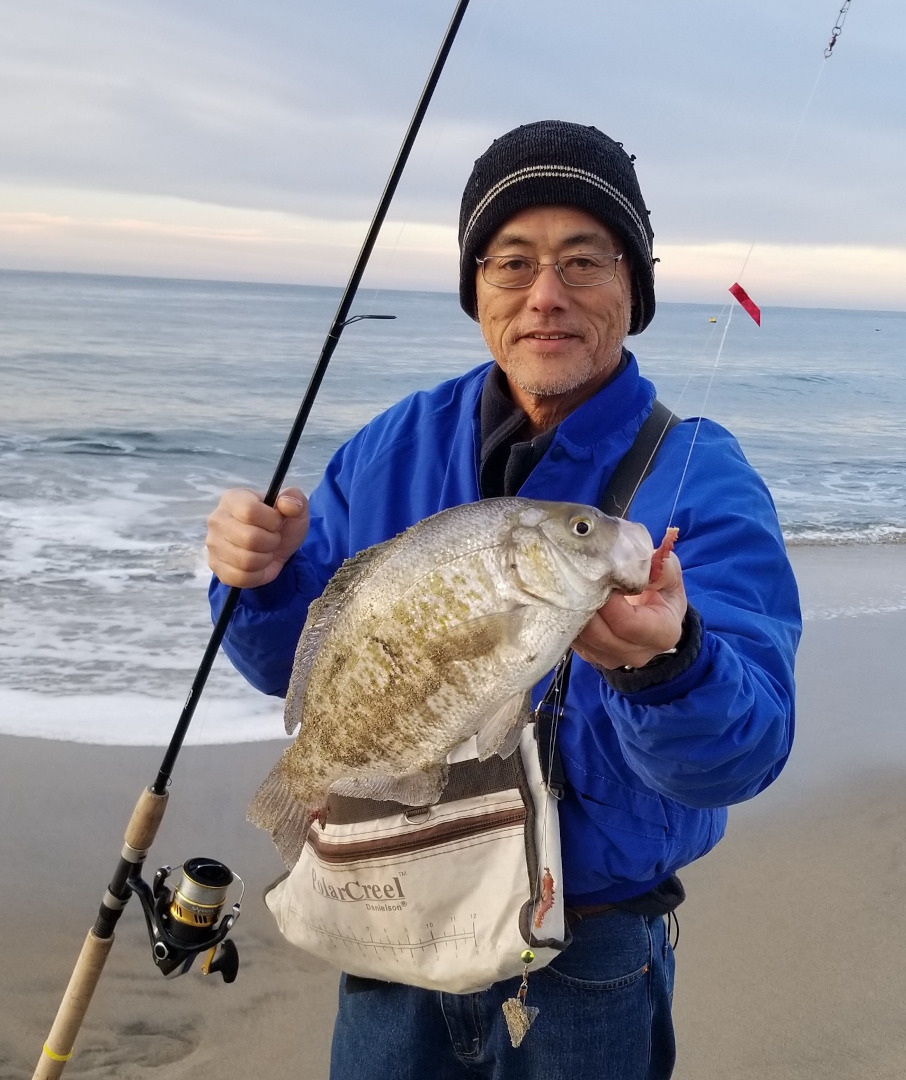Utah Fish Report
Santa Cruz Fish Report for 2-11-2022
Santa Cruz Fish Report for 2-11-2022
Use the right equipment, technique while surfcasting
Santa Cruz - Santa Cruz, CA

Alan Tani is best known for chasing big tuna and is a nationally recognized fishing reel expert. His brother Edward Tani finally talked him into surfcasting and Alan landed this montster 16.5-inch barred surf perch.
by Allen Bushnell
2-11-2022
Website
Besides “Crabs ’n Dabs,” the most consistent fishing around the Monterey Bay this time of year is surfcasting for big barred perch. Yes, most the fish are on the small side and at least half the surfcasters we know practice catch and release so it’s not necessarily a freezer-filling proposition. But it does take skill, luck and dedication to get good at surf fishing. Best thing is, the opportunity lies at any beach at the end of the street. Becoming aware of surfperch habits and using correct gear in a practical fashion can help solve the daily puzzle of “Where are the perch and how can I catch them?” The more we practice surfcasting, the more we enjoy it.
Last week we discussed location and conditions. Look for holes, throughs and rip currents, deeper spots where perch are most likely to be feeding. Fishing around the higher tides is usually best, because there’s more water to hold feeding fish close to shore. Sunset and sunrise are good times to fish as they seem to prefer lower-light conditions. Overcast days provide lower light for the fish, as does standing whitewater that extends over the deep spots as the waves roll in.
Almost any rod can be used catch fish from the surf. We prefer a long spinning rod with a fast tip. A 10-20-pound rating is just fine. Steelhead drift rods make excellent perch catchers. They are long enough to raise the tip and clear your line from incoming white water, keeping your line taut. Keeping all slack out of the line is important because perch usually don’t grab bait, they nibble. When we feel that slightest nibble, we halt our slow retrieve and let the fish play with the bait until we’re confident the fish has the bait in its mouth before setting the hook. We spool up a 2500-3000 size spinning reel with 15-pound braid for the main line then run a Carolina rig using 12-pound mono for the leader. A sliding egg sinker with a bead to protect the knot at the swivel completes the setup. Leaders can be as short as 18 inches or as long as 7 feet. We typically are run a four-foot leader that may shrink to three feet as we re-tie hooks. As for bait, most agree that GULP! 2-inch sandworms top the list. The worms come in a variety of colors, Camo or Blood colors are our favorites, though the new “New Penny” version works well as does the “Natural.” Other baits can include organics such as live sandcrabs, shrimp pieces or fresh mussel meat.
Swimming grubs would be number two on our list. there are a plethora of brands out there. Generally, any 1 1/2, 2 or 3-inch grub should work just fine. Popular colors include motor oil red or gold flaked, root beer and pure or purple haze white grubs. Grubs can be found with either curly tails or paddle tails.Either way, the technique we’ve found best for retrieving grubs is to keep them moving. Those little tails must be swimming to attract a bite.When the fish makes a grab, keep reeling. Don’t stop.The fish will usually follow and will likely make a firmer bite for the hookup.
Larger lures can work as well. Many experienced perch anglers use big lures as a technique to avoid catching too many little fish. The bigger more aggressive perch are more likely to attack a larger lure. Most popular around Monterey Bay and in Southern California are the Lucky Craft 110 or 115 stickbaits. these are diving plugs that float when you stop reeling, which helps to keep from dragging bottom and picking up debris. Our favorite color for the 110’s is the sardine color, with dark spots along the side.
Again, when a fish hits the lure, keep reeling, maybe just a bit slower. Don’t be afraid to firmly set the hook. Calissa Lures also make a line of 110’ and 115’s that work well. The difference is, you have to keep Calissas moving, as they will sink if you stop your retrieve. One or two inch KastMaster lures work surprisingly well for enticing a big perch bite. Again, a variety of colors are available. Out favorites are silver, silver/blue and gold. Using these bigger lures also increases the chance of hooking an “intended bycatch.” That is, larger fish such as halibut or stripers that can be found close to the sand, especially in the summer months.
More Reports
Tips to find success reeling in surfperch

2-4-2022
For a morning or afternoon jaunt locally, the beaches are producing increasing numbers of surf perch for Monterey Bay surfcasters....... Read More
Santa Cruz sees limited damage from tsunami

1-21-2022
Anglers who woke early and checked their internet or radios on Saturday morning January 15, 2022 were alarmed to learn...... Read More

www.UtahFishReports.com © 2025. All Rights Reserved.
Website Hosting and Design provided by TECK.net
Website Hosting and Design provided by TECK.net